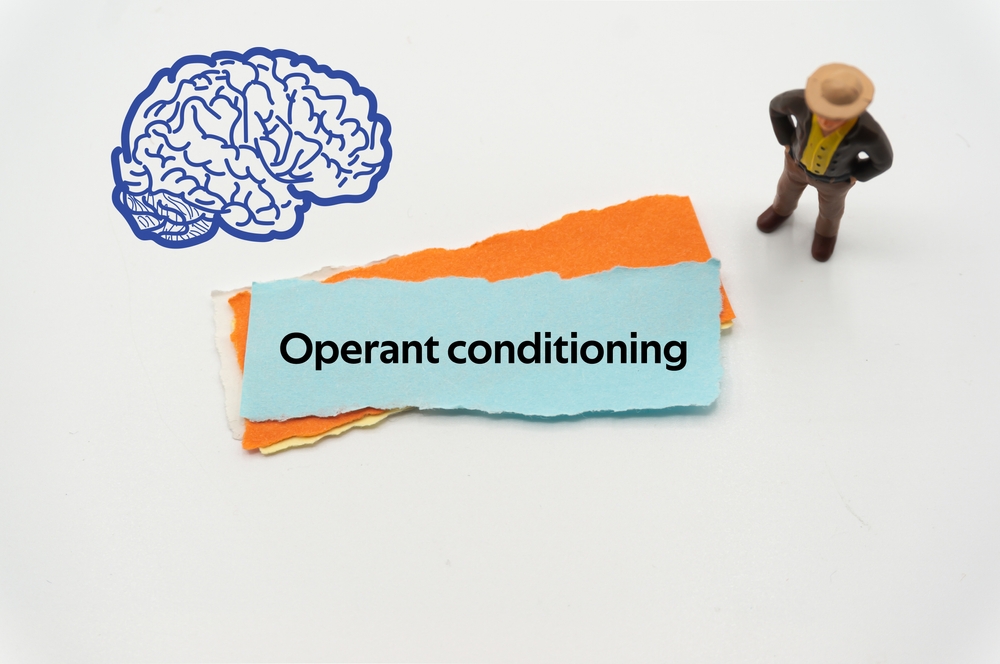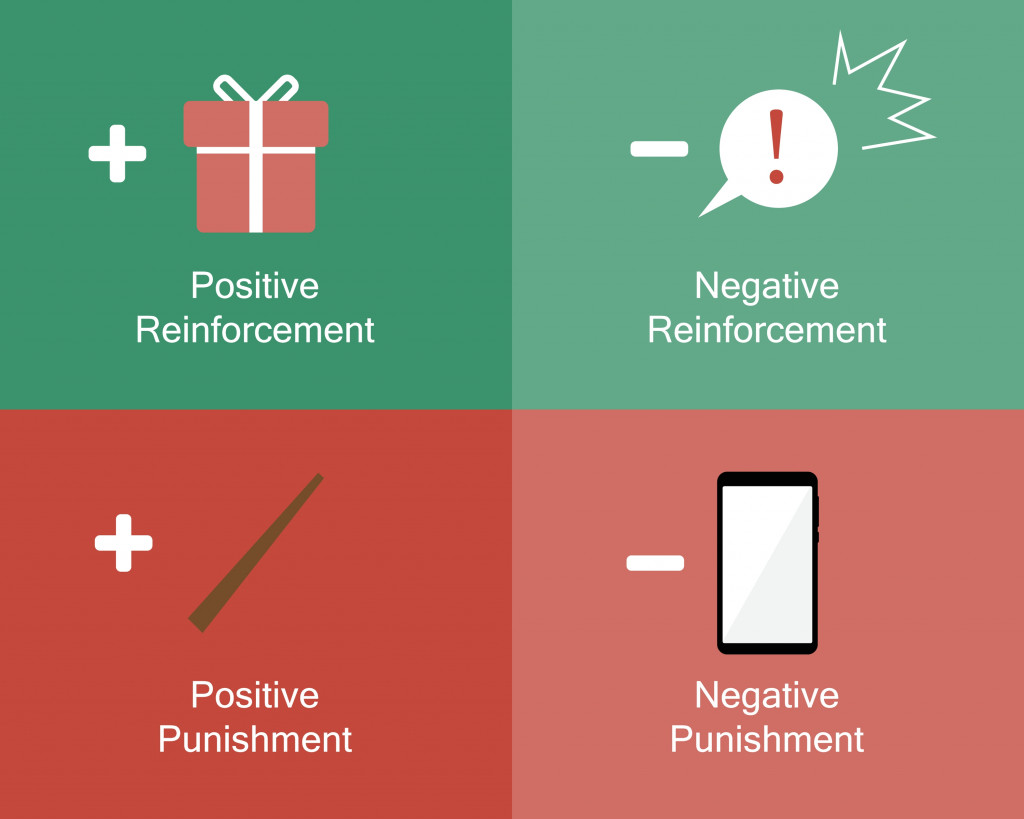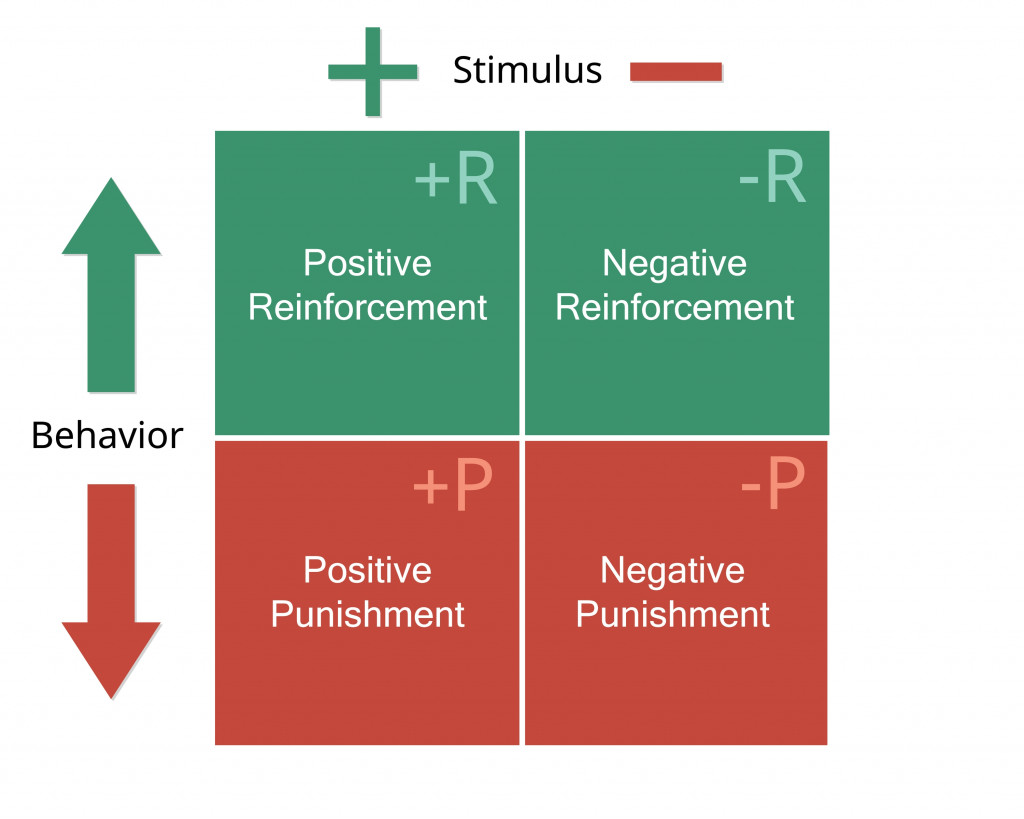Table of Contents (click to expand)
If an unwanted outcome is added or “applied” to act as a consequence, it is referred to as punishment. However, if something is taken away to avoid an undesirable unwanted outcome, it becomes negative reinforcement.
Negative reinforcement and punishment are often used interchangeably in pop cultural references, but they are two different concepts.
What Is Operant Conditioning?
Operant conditioning is a type of learning (others include classical conditioning and latent learning) where a person’s behavior is either rewarded or punished in order to enhance or reduce a certain response. Operant conditioning involves assigning a consequence to a behavior, regardless of whether that consequence is positive or negative.
Operant conditioning was first described by B.F. Skinner, which is why it is sometimes called Skinnerian conditioning. Based on Skinner’s behaviorism, it is not necessary to examine one’s internal thoughts or motivations in order to change or explain behavior. Human behavior can be explained by external factors that are observable, such as cues from the environment.
Operant behavior is any behavior that produces a consequence, according to Skinner.
An active behavior that operates on the environment to produce a general consequence is referred to as an “operant behavior” by Skinner.
A psychologist named Edward Thorndike proposed the Law of Effect, which heavily influenced Skinner’s theory. It states that an action leading to an undesirable outcome will likely be avoided, while one that leads to a desirable outcome is more likely to be repeated.
In essence, operant conditioning follows a simple principle: actions that are followed by reinforcement are likely to be strengthened and will be repeated in the future.

Also Read: What Is Positive Reinforcement And Negative Reinforcement?
Components Of Operant Conditioning
Reinforcement In Operant Conditioning
Reinforcement is any event—one that occurs as a result of a behavior—that will increase the likelihood of that behavior occurring in the future.
There are two types of reinforcement: positive and negative.
Positive reinforcers are favorable consequences presented after a behavior. Adding praise or a direct reward right after one performs a behavior will further strengthen that behavior. For example, if you give a series of well-constructed presentations at work and your employer consequently gives you a raise, the raise acts as a positive reinforcer to sustain and increase your behavior of doing a good job at work.
Negative reinforcers, on the other hand, remove an unfavorable consequence(s) or outcome(s) after engaging in a behavior. Since it is a type of reinforcement, the behavior is still strengthened, but the cause—removal of an outcome—changes. For instance, when a parent hands their screaming child a chocolate or toy to calm them down, the parent is negatively reinforcing their behavior of handing out treats to their child to avoid or remove the outcome of a wailing child.
The child in this situation is being positively reinforced to repeat the behavior of crying in order to receive a reward (a treat) for their behavior.
Punishment in operant conditioning
Punishment is referred to as an adverse event or outcome of a behavior that decreases the behavior. There are two kinds of punishment: positive or negative.
Positive punishment, also known as punishment by application, is an unfavorable event or outcome to weaken the response to the behavior it follows. For instance, spanking a child for misbehaving is an example of positive punishment.
Negative punishment, also known as punishment by removal, is when a favorable outcome is removed following a behavior. Taking away a child’s phone following their misbehavior is an example of negative punishment.

Also Read: Why Is It Hard To Stop Gambling?
How Punishment Is Different From Negative Reinforcement
There is one key distinguishing feature between punishment and negative reinforcement: addition or subtraction.
If an unwanted outcome is added or “applied” to behave as a consequence, it is referred to as punishment. However, if something is being taken away to avoid an undesirable unwanted outcome, it becomes negative reinforcement
For instance, if you complete your homework on time in order to avoid being yelled at by the teacher, that is negative reinforcement.
However, if you did something prohibited in class, such as chewing gum, and your teacher gives you detention and a task to write a 1000-word essay on why one should not chew gum in class, that is a punishment.
Take another example. If you avoid breaking a traffic rule to eliminate the undesirable outcome of getting a ticket, this is an example of negative reinforcement. However, if you break a traffic rule and receive a penalty, this will be considered a punishment, so you’re less likely to break the traffic rules again.

How Effective Is Negative Reinforcement In Changing Behavior?
Negative reinforcement is an effective way to strengthen desirable behavior. It is, however, most effective if the reinforcer is presented soon after a behavior. If there is a long gap between the behavior and the reinforcement, the response of the behavior repeating is less likely or weaker. However, some experts believe that negative reinforcement should be used in a limited amount in classroom settings, and instead emphasize the use of positive reinforcement in that space.
How Effective Is Punishment In Changing Behavior?
In some cases, punishment can be effective, but not always.
First, punishment is more effective if it quickly follows the behavior. Right after the unwanted behavior has occurred, it should be followed by punishment. Courts can take time to punish an accused, which could be why prison sentences may not always lead to reduced crime rates.
Second, punishment should be consistent. If the behavior is inconsistently punished, the unwanted behavior will continue. For instance, if you are punished consistently with speeding tickets, you will not drive over the speed limit. However, because this behavior is inconsistently punished, people continue to drive over the speed limit.

Drawbacks And Consequences Of Punishment
Punishment is not without its drawbacks. It has been observed that the behavioral changes following punishment are temporary. Skinner, in his book “Beyond Freedom and Dignity,” explains that punished behavior is likely to reoccur after the consequences of punishment are withdrawn.
The biggest drawback of punishment is that you learn what not to do, but punishment does not teach you what you should do.

One more thing to consider about punishment is that it can lead to undesirable consequences. A survey in 2014 found that half of American parents admitted that they resort to spanking their young children (9 years or younger) for their mistakes. However, research has found that this type of physical punishment may increase antisocial behavior, aggression, and even delinquency in children.
How well do you understand the article above!

References (click to expand)
- Staddon, J. E. R., & Cerutti, D. T. (2003, February). Operant Conditioning. Annual Review of Psychology. Annual Reviews.
- Sprouls, K., Mathur, S. R., & Upreti, G. (2015, January 6). Is Positive Feedback a Forgotten Classroom Practice? Findings and Implications for At-Risk Students. Preventing School Failure: Alternative Education for Children and Youth. Informa UK Limited.
- Fazel, S., & Wolf, A. (2015, June 18). A Systematic Review of Criminal Recidivism Rates Worldwide: Current Difficulties and Recommendations for Best Practice. (A. R. Hernandez Montoya, Ed.), Plos One. Public Library of Science (PLoS).
- Punishment Strategies: First Choice or Last Resort. aasep.org
- Finkelhor, D., Turner, H., Wormuth, B. K., Vanderminden, J., & Hamby, S. (2019, May 22). Corporal Punishment: Current Rates from a National Survey. Journal of Child and Family Studies. Springer Science and Business Media LLC.
- Skinner B. F. (2002). Beyond Freedom and Dignity. Hackett Publishing
- Thorndike, E. L. (1927, December). The Law of Effect. The American Journal of Psychology. University of Illinois Press.
